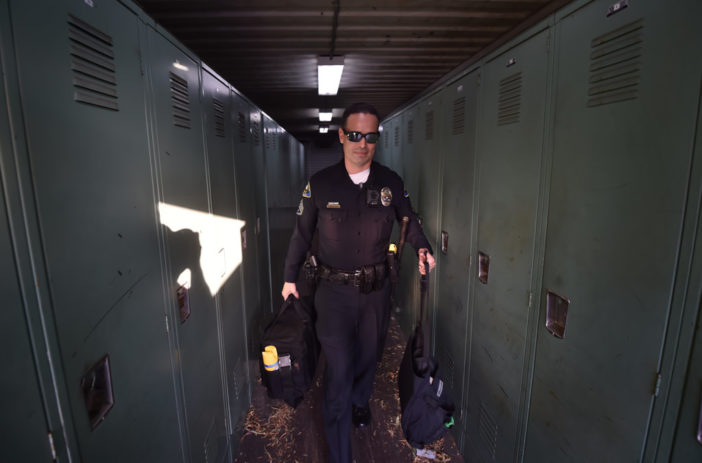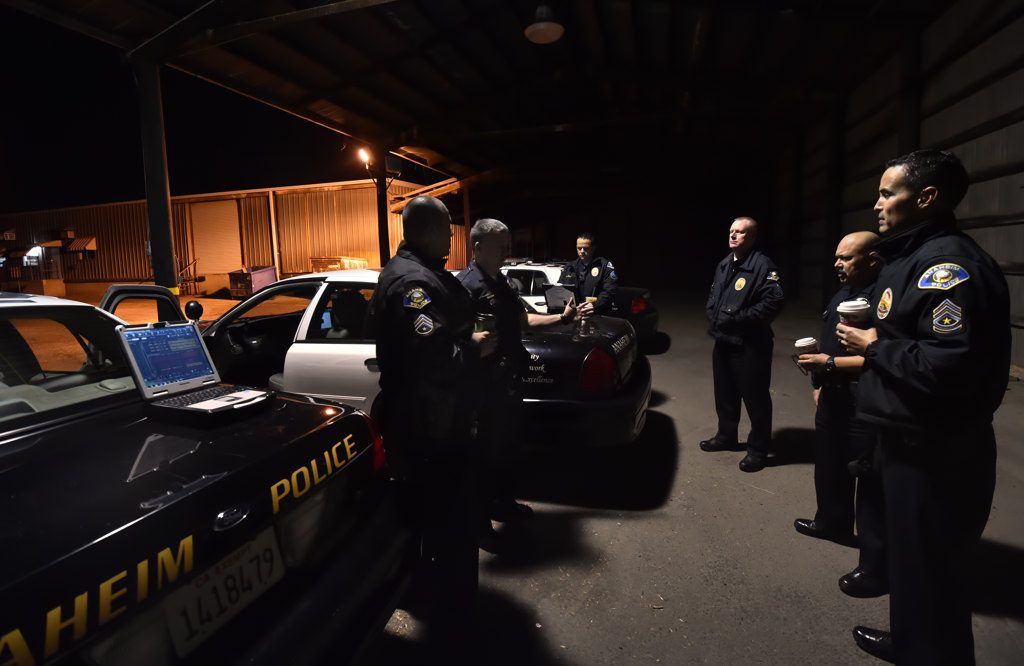Home.
Every day, they pray they will get back safely.
For now, it’s time for the patrol officers on the Anaheim PD’s Team 5 shift to get to work.
It’s 2:30 p.m. on a Thursday in mid-December, and more than a dozen officers are sitting in the Anaheim PD’s briefing room. Their shift will end the next morning at 3 a.m.
Their goal, as always, is to keep Anaheim safe — as well as themselves.
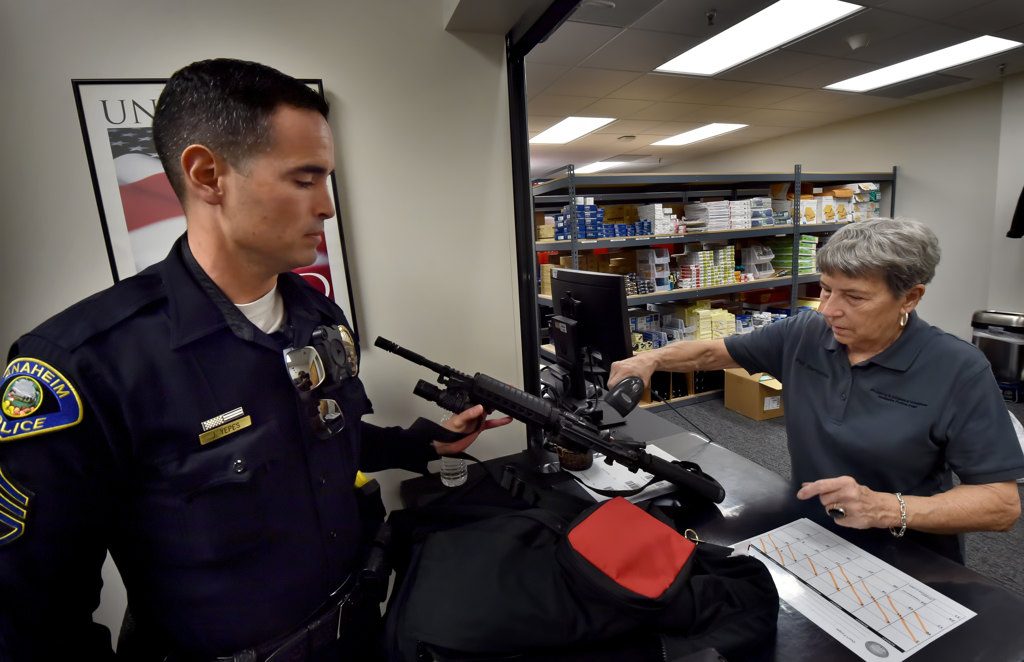
Pat Bartolone, a property and evidence volunteer for the Anaheim PD, scans the AR-15 rifle Sgt. Jon Yepes is checking out at the start of his shift.
Photo by Steven Georges/Behind the Badge OC
The two shift sergeants, Jonathan Yepes and Kelly Phillips, are giving a slide-show presentation about civil and criminal trespassing laws in California. At most shift briefings, sergeants like to follow their updates about what crimes are being worked in the city with something educational, usually concerning police tactics and the law.
Then, at around 3 p.m., it’s time for Team 5 patrol officers to gather their equipment, disperse into their vehicles and hit the streets. Team 5 officers try to take the lead on most calls so the officers who began their day at 6 a.m. can get off at 6 p.m. After that, at 6 p.m., graveyard shift officers join Team 5 officers in patrolling the city.
Yepes has been a patrol sergeant for almost four years. He says it’s the best assignment he’s had during his 17 years in law enforcement, which included stints at the Los Angeles County Sheriff’s Department and the City of Downey before he transferred to the APD in 2006.
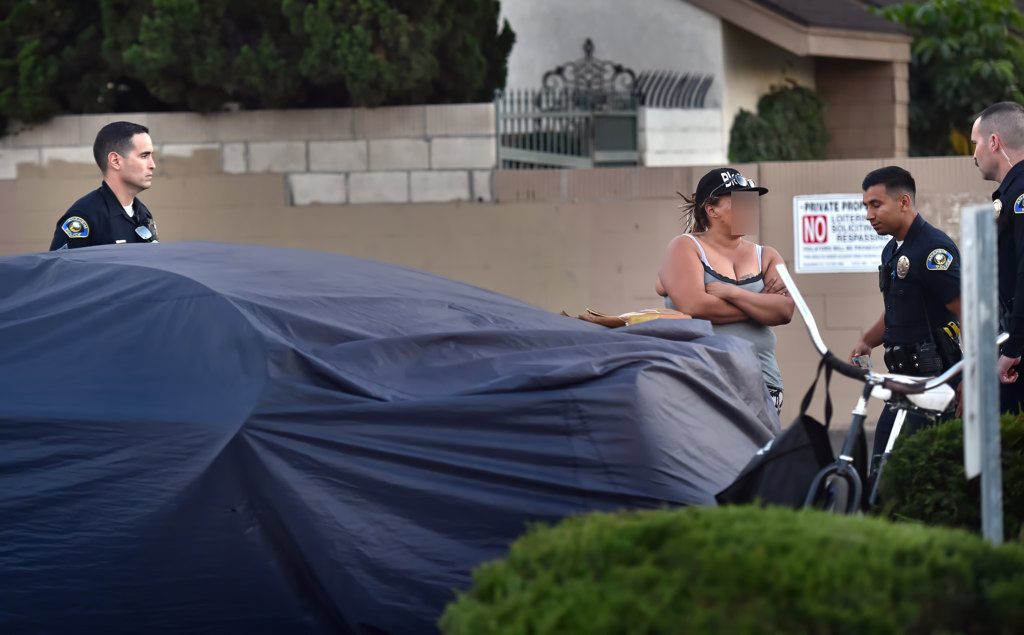
Anaheim PD Sgt. Jon Yepes, left, stays with officers checking out a report of a person inside a covered car in the parking lot of a strip mall. After talking to the woman, they discovered that she was staying there temporarily with the permission of the business she was parked near.
Photo by Steven Georges/Behind the Badge OC
“I enjoyed working gangs and, as a detective, working robberies,” Yepes said of his other APD assignments. “I’ve also been a sergeant in internal affairs — that can be stressful. There’s a lot of freedom being a patrol sergeant, but then there’s also a lot of responsibility. I’m not only worried about myself, I’m also worried about the other officers and their welfare, and making sure they’re doing the right thing.”
Like he does all days when he works, Yepes got up around 9:30 a.m. after five hours of sleep. On this day he got in a few sets of pushups instead of his usual biking-and-weights routine to catch up over coffee with his 18-year-old daughter, who arrived for the holidays from college out of state.
The athletic Yepes is a regular cycling participant in the World Police and Fire Games.
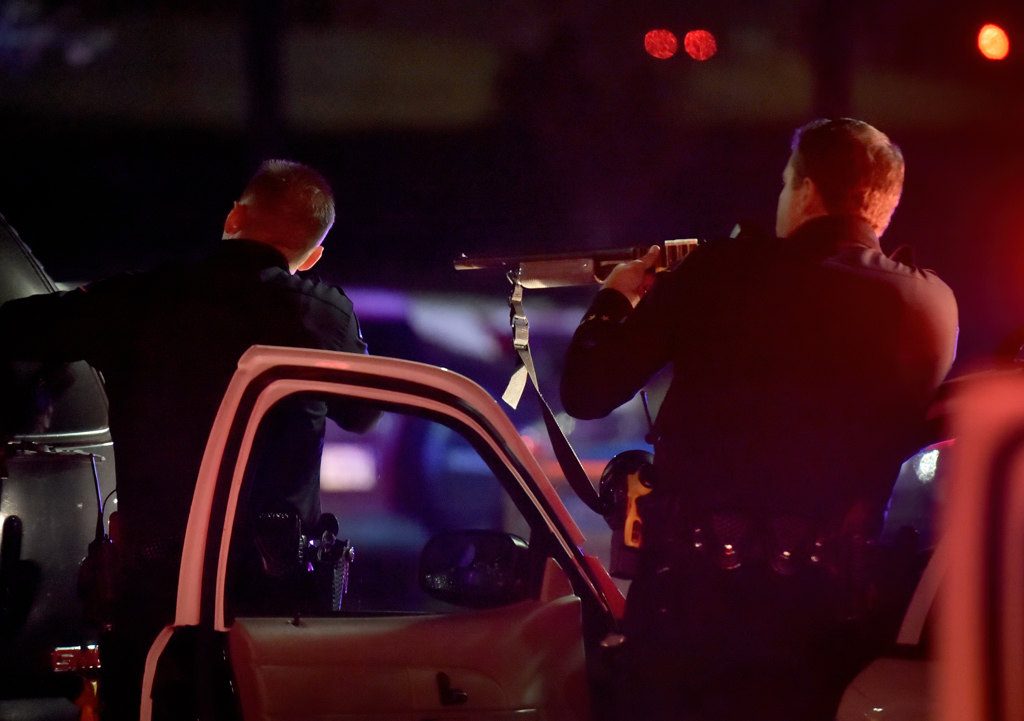
Anaheim PD officers order a man reported to have flashed a gun at someone in the parking lot of an Anaheim strip mall to get out of his car with his hands up. The gun was found to not be real.
Photo by Steven Georges/Behind the Badge OC
GEARING UP
After the briefing, Yepes checks into the property room and is given keys to a Chevy Tahoe, a roomier patrol vehicle reserved for sergeants. He is given a rifle and Narcan, a medication officers recently began equipping themselves with to reverse the effects of opioid overdoses.
Just before 3:30 p.m., Yepes inspects the Tahoe. A germ freak, he uses disinfecting wipes to clean the door handles and steering wheel.
Patrol officers always try to avoid the “s” (for slow) and “q” (for quiet) words when it comes to describing how things are going in the city.
A reporter makes the gaffe of asking Yepes if he’s expecting a quiet shift.
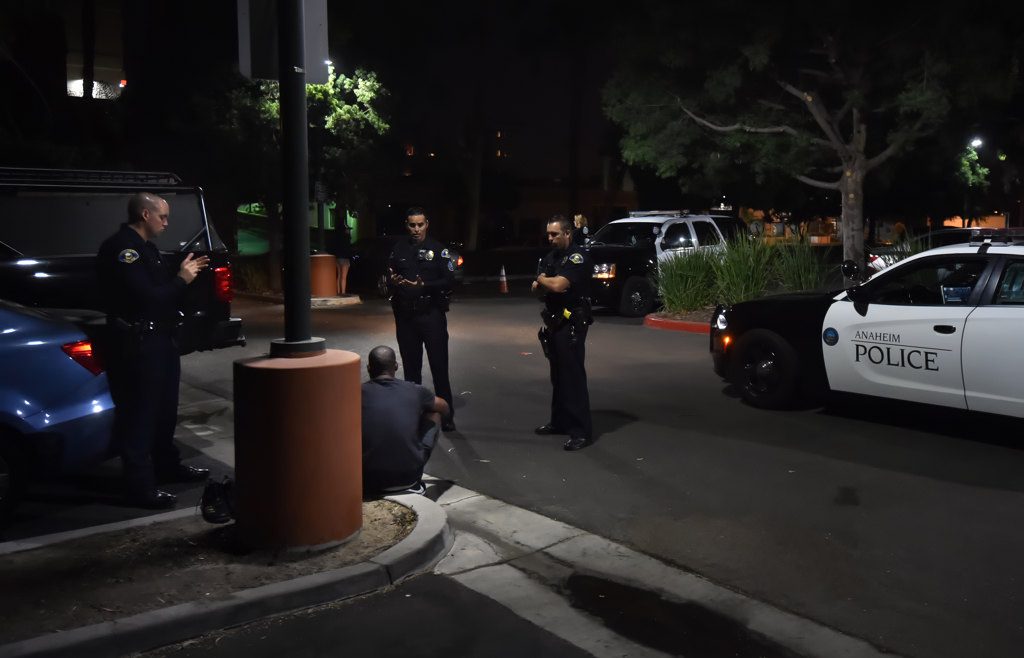
Anaheim PD officers, including Sgt. Jon Yepes, center, check on a family dispute in the parking lot of a hotel involving the ownership of a car parked there. Photo by Steven Georges/Behind the Badge OC
“Knock on head,” the good-natured Yepes says as he gently raps his knuckles on his skull. “If it’s a busy shift for us, that usually means it’s a bad day for other people.”
The East L.A. native always considered becoming a cop.
“I watched ‘CHiPs’ and wanted to be Frank Poncherello,” Yepes said of the California Highway Patrol motor officer immortalized in the TV series by actor Erik Estrada.
When Yepes was 24 and newly married, working in customer service in a warehouse, an uncle, a retired LASD captain, urged him to test with that agency.

A young man runs as police arrive in the neighborhood near Little People’s Park in Anaheim after receiving a call of someone bleeding from a gunshot wound. Some of those who ran were caught as police assessed the situation.
Photo by Steven Georges/Behind the Badge OC
He did, and he hasn’t looked back since.
Yepes, a 44-year-old father of two whose wife is a nurse, places a soft blue ice chest in the Tahoe. It’s packed with water, gluten-free rice cakes, peanut butter and other snacks. Sometimes the ice chest is a lifesaver when Yepes doesn’t have time for a proper meal.
The rear of the Tahoe is a quasi-mobile command center that includes a whiteboard and radio. It’s also where Yepes places his AR-15 semiautomatic rifle beside a rifle that fires less-lethal rounds. Among the other equipment in Yepes’ patrol vehicle is a helmet and a gasmask.
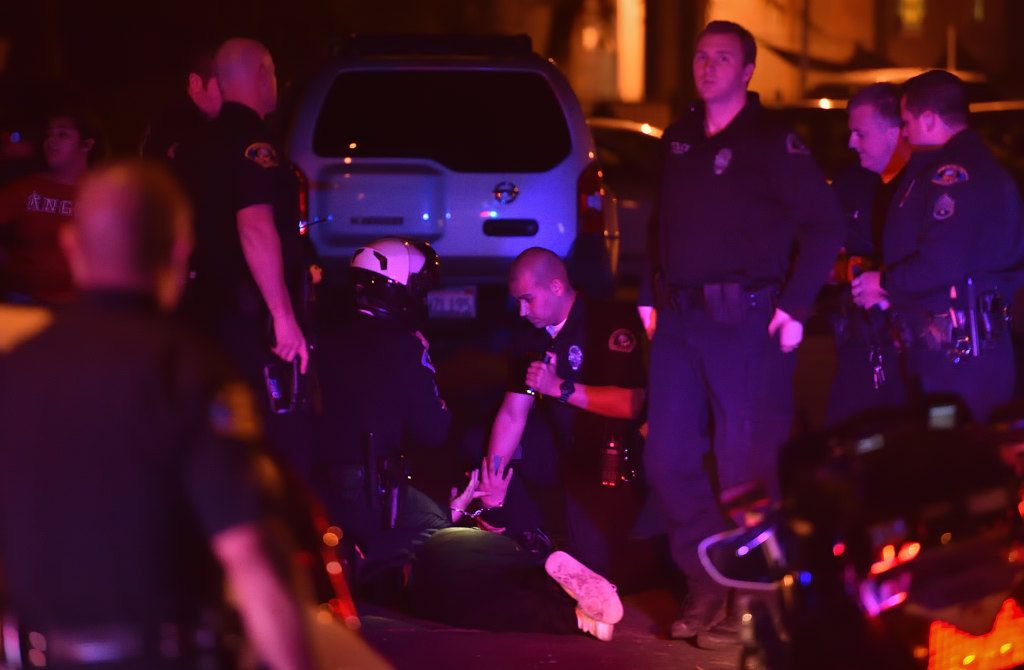
Police stop a young man who ran as police showed up at a neighborhood after receiving a call of someone bleeding from a gunshot wound.
Photo by Steven Georges/Behind the Badge OC
Yepes takes the Tahoe through a nearby car wash — that’s the neat freak in him coming out again — and begins patrolling the streets.
“I was taught in the academy that how we are perceived is important,” says Yepes, his polished black boots giving off a glossy sheen. “I don’t want any of my officers looking like a soup sandwich. If they do, some of the criminals are likely to test them.”
His personal mobile phone pings, indicating his 14-year-old son has just gotten home. Yepes’ phone also automatically goes off when his son arrives at and leaves school.
His daughter has a slightly looser leash.
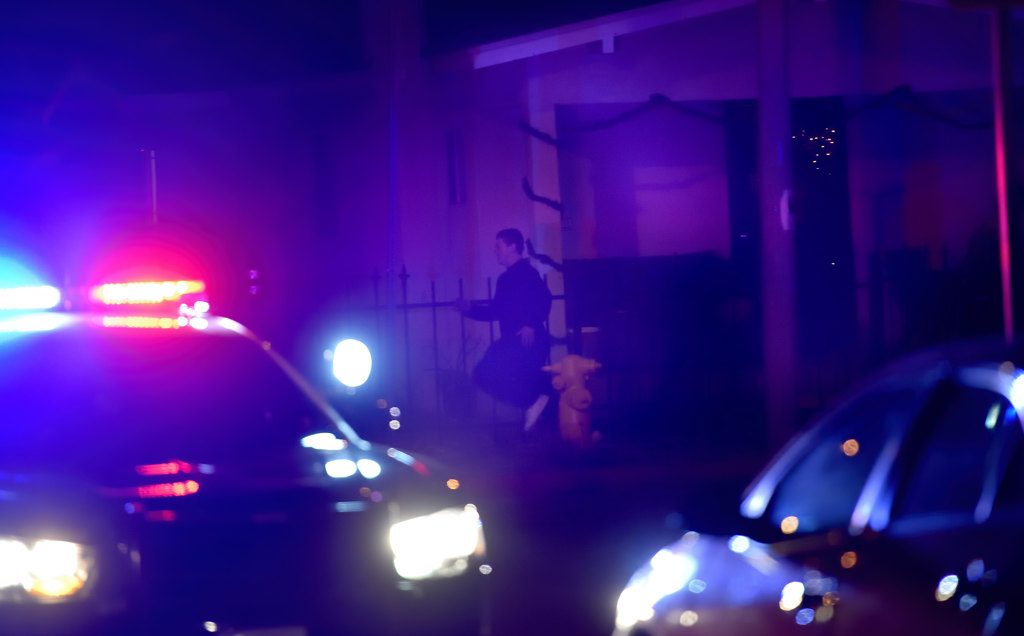
A young man runs as police arrive in the neighborhood around Little People’s Park after receiving a call of someone bleeding from a gunshot wound. Photo by Steven Georges/Behind the Badge OC
RHYTHMS OF THE NIGHT
From his computer inside the Tahoe, Yepes monitors calls as they are placed in a queue by dispatchers. As a patrol sergeant, he has the freedom to decide which calls to roll to.
A big part of his job is making sure calls “come off the board” in a timely manner — even low-level ones. Yepes gets antsy if routine calls aren’t responded to within an hour.
During parts of his shift when he has time, Yepes will review on the computer reports coming in from officers in the field.
“At the end of the shift (when fatigue sets in), they get harder to read,” Yepes says.
Yepes and Phillips divide up the city, with Yepes handling west and south. Later, graveyard shift sergeants will join them.
As a sergeant, Yepes doesn’t want to create more work for his officers by initiating lots of stops.

Anaheim police check out a car that appeared to have been abandoned in the middle of a residential street. The owners eventually showed up to claim the car.
Photo by Steven Georges/Behind the Badge OC
A Mustang GT swerves in and out of lanes.
Yepes decides to pull over the driver, who failed to use a blinker. He gives a warning to the motorist, a young man who tells Yepes he’s rushing to school from work.
Being a cop has made Yepes a cautious driver.
“My wife makes fun of me because I drive so slow,” Yepes says. “She calls me an old man.”
Yepes decides to roll to a call of a suspicious vehicle parked in a small strip mall. Two patrol officers greet him at the scene. A woman tells them she has permission from a business owner to keep the broken-down, covered car there.
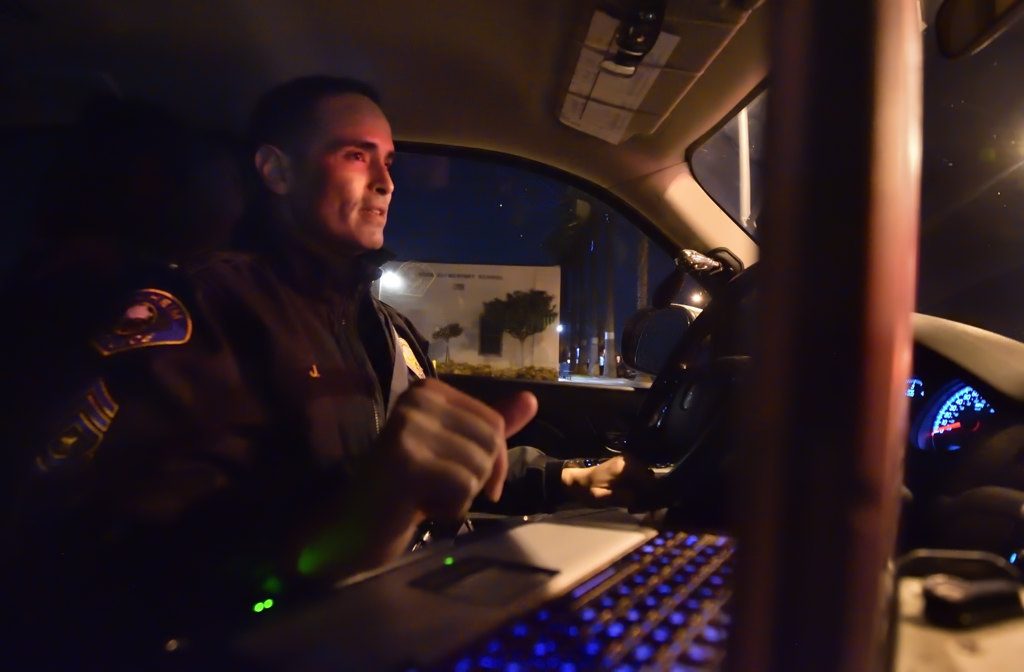
Anaheim PD Sgt. Jon Yepes reviews reports from other officers in the field from his patrol car laptop.
Photo by Steven Georges/Behind the Badge OC
“A big part of being a patrol sergeant is managing people’s personalities,” Yepes says after he gets back in his car. “Sometimes you have to be stern, other times you have to finesse.
“For the most part, based upon my experiences as a police officer, they (APD patrol officers) respect my background and know I’m an easygoing person, but they also know if I see something wrong, I’m going to let them know. I’ve had people tell me that they’ve been disappointed in themselves when they let me down, so I think that’s a compliment.”
Patrol shifts can turn on a dime from routine to Code 3, with lights and sirens blaring.
After checking out three other calls, including one regarding a man with a gun in a car in the parking lot of a crowded shopping plaza (it turned out to be an airsoft gun), Yepes, at 7:38 p.m., went Code 3 to a call that turned out to be the most eventful of the shift.
The call went out as a man with a gunshot wound near Little People’s Park near downtown Anaheim, just down the street from police headquarters and two blocks from City Hall.
About a dozen units on the ground, and Angel (the APD’s air support unit) in the sky, swarmed to the scene.

Anaheim police officers, including Sgt. Jon Yepes, center, question a couple of teens at Little People’s Park in Anaheim after receiving a call of someone bleeding from a gunshot wound.
Photo by Steven Georges/Behind the Badge OC
Some youngsters fled from police as they arrived.
Two were arrested for fighting with officers.
Turns out the reporting party who said a man had been shot had been wrong. The man turned out to be a homeless guy had fallen out of a tree and gashed his hand. He walked into an AA meeting and someone called 911.
Patrol is like that: An officer thinks he or she is responding to a certain call, when the reality of the call turns out to be much different.
“You come across people on their best day or their worst day,” Yepes said of patrol.
He recalled a kid who saw an elderly woman getting robbed. The youngster chased down the bad guy with no regard for his personal safety.
“That was kind of awesome,” Yepes says.
He adds: “The bad calls always stick out in your mind.”
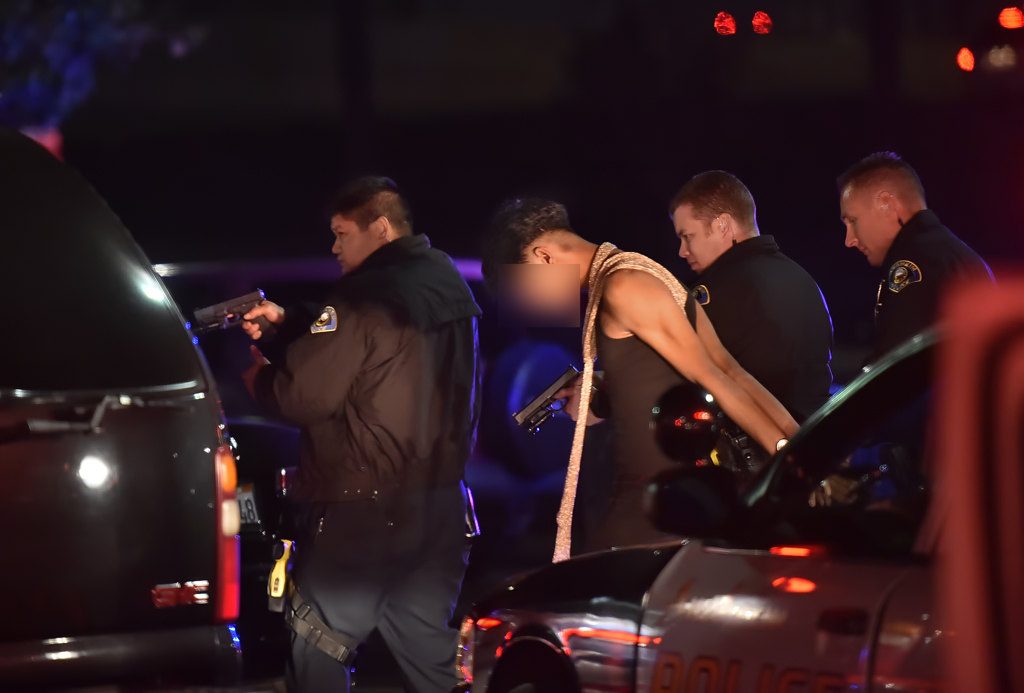
Anaheim PD officers check to see if anyone else was in a car as a driver is detained in the parking lot of a shopping center after a report of a man flashing a gun. The gun was found to not be real.
Photo by Steven Georges/Behind the Badge OC
One of Yepes’ first calls as a patrol officer involved a baby not breathing.
Yepes’ training officer performed CPR on the baby, but the baby died at the hospital.
“I can still see their faces now,” Yepes says of the parents. “They had this look of despair and heartache, and there was nothing I could do or say to make things better.”
A HUDDLE
At 8:46 p.m., while reading reports in the parking lot of a post office, Yepes steps out of his car to call his wife, Maria.
He checks in with her during every shift when he can.
“Tomorrow’s her birthday,” Yepes says.
At 10:10 p.m., Yepes stops at a red light while heading to another lower-priority call. Several youngsters walk through the crosswalk with a teenager — they had just played soccer — and wave at Yepes.
“It’s nice to see that,” Yepes says.
The motorist next to him rolls down the passenger window to say something to Yepes.
The sergeant rolls down his window.
“Where’s the media when you need them?” the smiling stranger asks Yepes.
“They’re right here,” Yepes says, pointing out the reporter and photographer in his car.
To break up the loneliness that sometimes creeps in while patrolling around solo in his sergeant’s vehicle, Yepes will rendezvous with his fellow sergeants for a short debriefing/shoot-the-breeze session at a place they call “The Tracks” because of its proximity to a railroad.
They usually try to meet at 10 p.m., but on this night, Yepes doesn’t get there until 11:10 p.m.
They place their coffees on the backs of their patrol cars.
Some of the discussion centers on the incident at Little People’s Park.
A lot of it concerns a Christmas dinner they recently shared.
Good-natured ribbing ensues.
At The Yard, railroad officials have given the APD officers access to a break room. In it is a microwave, snack machine and bathroom.
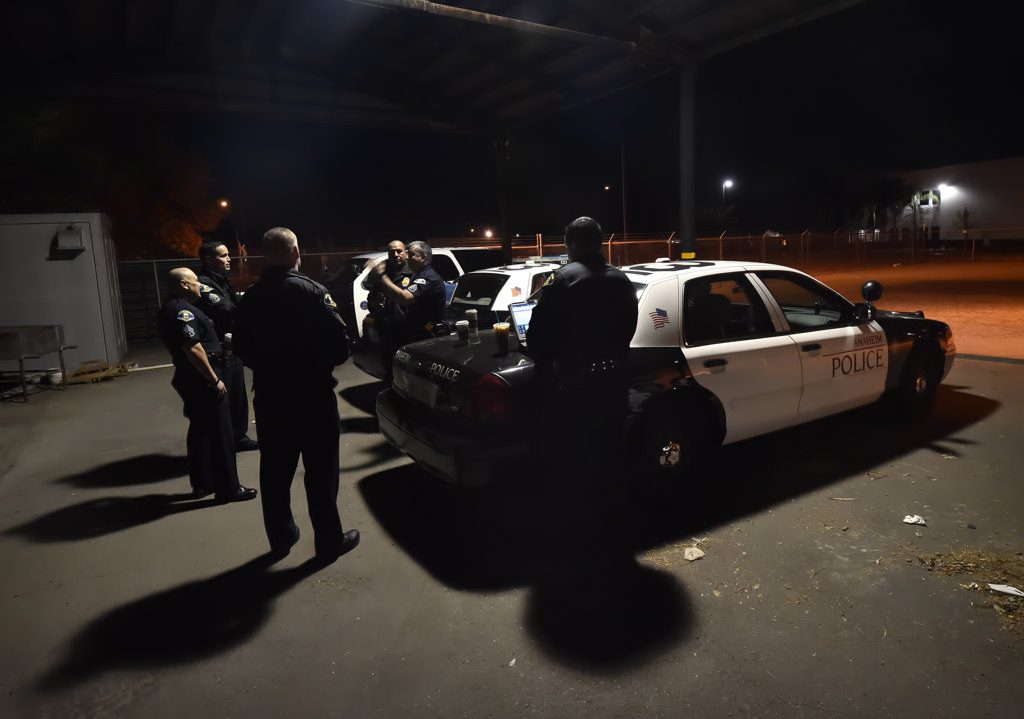
Close to midnight, sergeants meet at an isolated location in Anaheim to discuss how the night is going and what to look out for as it progresses.
Photo by Steven Georges/Behind the Badge OC
It’s an important meet-up for the sergeants to swap stories and chase away images of some of the bad stuff they may have encountered so far during their shift.
At around 2:15 a.m., after responding to two other minor calls, Yepes heads back to the parking lot of APD headquarters to finish up clearing reports from inside his Tahoe.
He then enters the station to make himself available to sign documents from his team of patrol officers heading back to the station (some require a sergeant’s signature).
He then showers, dresses back into his civilian clothes, and gets into his personal car.
Then he drives back to where his long workday began:
Home.
 Behind the Badge
Behind the Badge
